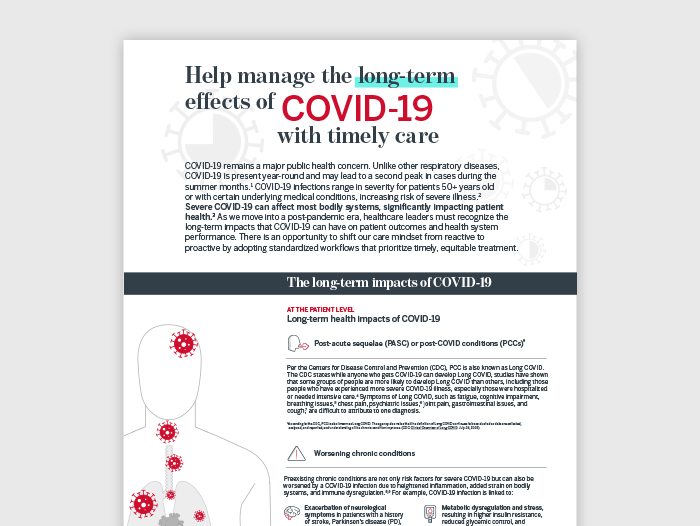Auto logout in seconds.
Continue LogoutCDC data shows that COVID-19 hospitalizations are still rising across the United States, and the agency predicts that hospitalizations will continue to increase over the next month.
COVID-19 hospitalizations continue to rise across the US
According to CDC data, COVID-19 hospitalizations have been increasing steadily nationwide since July, and the agency forecasts that there will be an acceleration in hospitalizations over the next month. Previously, CDC had projected that hospitalizations would either "remain stable or have an uncertain trend."
For the week ending Aug. 12, which was the latest week with data available, there were 12,613 COVID-19 hospitalizations, a 21.6% increase compared to the week before. Across the United States, 29 states saw substantial increases (20% or more) in COVID-19 hospitalizations, and 11 states had moderate increases (between 10% and 19.9%).
This increase in hospitalizations comes as several new omicron subvariants are circulating across the country, including EG.5.1 ("Eris") and BA.2.86 ("Pirola"). So far, CDC has said "the current increase in hospitalizations in the United States is not likely driven by the BA.2.86 variant," but "[t]his assessment may change as additional data become available."
Will COVID-19 ever become seasonal?
Most respiratory viruses, including influenza and respiratory syncytial virus, generally have a predictable seasonal pattern, but that has not yet happened with the SARS-CoV-2, the virus behind COVID-19. Currently, health experts have differing opinions about SARS-CoV-2's potential seasonality, with some saying that the virus is already seasonal or close to it and others saying it's too early to determine.
Michael Mina, an infectious disease epidemiologist, said he believes that SARS-CoV-2 has already been displaying seasonal behavior since there are "certain periods of time [that] are going to see increases and decreases, but not necessarily that it has to just be winter or summer."
Ben Cowling, an infectious disease epidemiologist at the University of Hong Kong, said he believes SARS-CoV-2 does not yet have a predictable or seasonal pattern, but that the virus is on its way there. "At the moment I don't think Covid is predictable but it is showing all the signs of becoming the fifth 'human coronavirus’ along with OC43, NL63, 229E and HKU1," he said.
However, other health experts disagreed, saying there is no clear evidence of the coronavirus becoming seasonal just yet.
"I don't see clear seasonality for SARS-CoV-2 yet," said Kanta Subbarao, director of the World Health Organization's (WHO) Collaborating Centre for Reference and Research on Influenza at the Peter Doherty Institute for Infection and Immunity in Australia.
Michael Osterholm, director of the University of Minnesota's Center for Infectious Disease Research and Policy, expressed a similar sentiment. "There just isn't a definable pattern yet that would call this a seasonal virus," he said. "That's not to suggest it might not be some day."
According to Maria Van Kerkhove, WHO's technical lead for COVID-19, some of the transmission patterns that are being observed are examples of periodicity rather than seasonality. "If you kind of squint, you could see a little, you know, in different places," Van Kerkhove said. "I think you can see sort of waves of infection every five, six months or so depending on the population. But that isn't at a national level. … And it's not hemispheric."
There is also the possibility that a new COVID-19 variant, especially one that can easily bypass immunity, will emerge and disrupt any potential patterns the virus may be falling into due to human behavior or environmental factors.
"I think that — at this stage — all we can say is that we can assume that there are some seasonal effects (since we know seasonality does have an effect on other respiratory infections, both by effects on virus stability and on the host) but that we really cannot say the circulation of these viruses is predictable yet, at least not like we have come to know for flu," said Marion Koopmans, head of virology at Erasmus Medical Center in the Netherlands. (Branswell, STAT, 8/23; Tin, CBS News, 8/24; CDC COVID-19 Data Tracker, accessed 8/25)
As case counts increase across the country rise as a result of COVID-19, hospitals and health systems already strained by staffing shortages must be ready to confront the challenges at stake. Access the collection of our best resources and insights for creating capacity, supporting staff, communicating with patients, and more.
Don't miss out on the latest Advisory Board insights
Create your free account to access 1 resource, including the latest research and webinars.
Want access without creating an account?
You have 1 free members-only resource remaining this month.
1 free members-only resources remaining
1 free members-only resources remaining
You've reached your limit of free insights
Become a member to access all of Advisory Board's resources, events, and experts
Never miss out on the latest innovative health care content tailored to you.
Benefits include:
You've reached your limit of free insights
Become a member to access all of Advisory Board's resources, events, and experts
Never miss out on the latest innovative health care content tailored to you.
Benefits include:
This content is available through your Curated Research partnership with Advisory Board. Click on ‘view this resource’ to read the full piece
Email ask@advisory.com to learn more
Click on ‘Become a Member’ to learn about the benefits of a Full-Access partnership with Advisory Board
Never miss out on the latest innovative health care content tailored to you.
Benefits Include:
This is for members only. Learn more.
Click on ‘Become a Member’ to learn about the benefits of a Full-Access partnership with Advisory Board
Never miss out on the latest innovative health care content tailored to you.

